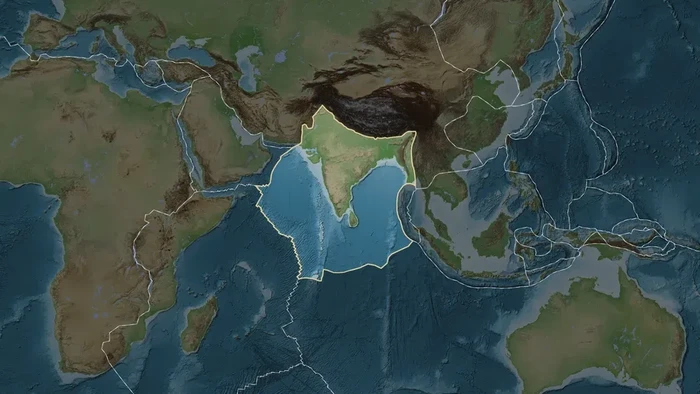Unbeknownst to many, the Earth's lithospheric plates are in a perpetual dance, continually shifting and shaping the planet's surface. Recent findings suggest that one of these movements may lead to the division of vast landmasses. Aside from Africa, the Indian subcontinent is now forecasted to undergo a profound transformation, potentially splitting into two separate entities.

A groundbreaking study has shed light on the possibility that the Indian tectonic plate is currently undergoing horizontal separation, dividing into two thick layers, each approximately 100 kilometers in depth. This phenomenon diverges from the vertical splitting observed in East Africa, where the formation of new microcontinents occurs. In India, the separation appears to be occurring horizontally as it converges with the Eurasian tectonic plate.
The Himalayas, the world's tallest mountain range, stand as a testament to this geological drama, with the Tibetan Plateau as its distinctive hallmark. India's northward movement, averaging 1-3 kilometers per year over 60 million years, is acknowledged as the primary force behind the Himalayas' formation. However, the exact mechanisms behind the creation of the Himalayas and the Tibetan Plateau remain subjects of debate.
Various theories attempt to elucidate this phenomenon. One posits that the Indian Plate is too buoyant to subduct into the mantle, instead sliding beneath the Eurasian Plate and creating the bulge that forms the Tibetan Plateau. Another suggests that the Indian Plate is stretching, akin to pulling a piece of paper upright, with Tibet formed by the bulge.
As reported by IFLSCIENCE on Tuesday, December 12, 2024, a third option was proposed at the American Geophysical Union Conference. According to this perspective, the Indian Plate is undergoing delamination. Consequently, its upper portion peels away to support Tibet, while the denser lower portion sinks into the mantle. Researchers speculate that this buoyant upper portion, of sufficient thickness to account for Tibet's elevation, behaves akin to an oceanic plate forced beneath a continental one.
"We didn't know continents could behave this way, and that, for solid earth science, is quite fundamental," remarked Professor Douwe van Hinsbergen from Utrecht University, not involved in the study, to Science Magazine.
The significance of this discovery is underscored by the fact that it marks the first time a continent has been observed undergoing delamination, according to Professor Douwe van Hinsbergen of Utrecht University. Although drilling to a depth of 100 kilometers to verify this idea is unfeasible, researchers gleaned insights from helium seeping through Tibetan springs.
"It's the first time that it's been caught in action delaminating," van Hinsbergen told Science Magazine. komentar di html
Helium-3, exceedingly rare on Earth and presumed to originate from the planet's formation, was found in high concentrations in certain Tibetan springs. Led by Simon Klemperer of Stanford University, researchers concluded that the mantle lies close enough to the surface in northern Tibet for helium-3 to reach these springs. Conversely, further south, leaked gases primarily contain helium-4, indicating that the plate remains intact, forming an impermeable barrier to helium. One exception is the area near Bhutan, where researchers suspect the mantle has breached the crust, yielding peculiar signals.
Seismic patterns in the region also support this hypothesis, indicating mantle intrusion from the eastern side of the plateau. The authors posit that the Indian Plate's thicker northern portion and thinner flanks may have facilitated this process. With the center of the plate sinking faster, even the relatively low pressure from mantle material above the plate's bottom can induce delamination.
Although our understanding of these geological processes necessitates further research, these findings open new avenues for earth science perspectives, enhancing our comprehension of how continents undergo profound changes over geological timescales.



